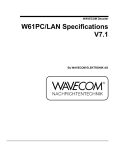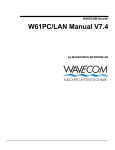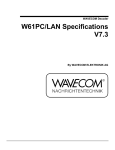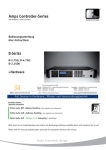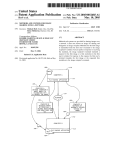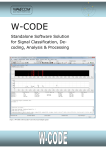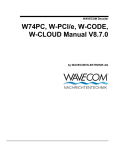Download WAVECOM EasySat System Software V1.2 User Manual
Transcript
WAVECOM EasySat System Software V1.2 User Manual by WAVECOM ELEKTRONIK AG PUBLISHED BY WAVECOM ELEKTRONIK AG Hammerstrasse 8 CH-8180 Buelach Switzerland Phone Fax Email: Internet: +41-44-872 70 60 +41-44-872 70 66 [email protected] http://www.wavecom.ch © by WAVECOM ELEKTRONIK AG. All rights reserved. Reproduction in whole or in part in any form is prohibited without written consent of the copyright owner. The publication of information in this document does not imply freedom from patent or other protective rights of WAVECOM ELEKTRONIK AG or others. All brand names in this document are trademarks or registered trademarks of their owners. Specifications are subject to change without further notice Printed: Tuesday, November 23, 2010, 17:03:45 Contents Welcome 1 Training ....................................................................................................... 1 Company Profile ........................................................................................... 1 Revisions ..................................................................................................... 1 References ................................................................................................... 2 Description of the System 2 Introduction ................................................................................................. 2 Hardware 2 Antenna/LNA ................................................................................................ 3 Down converter ............................................................................................ 3 PC(s) with W61PC(s) ..................................................................................... 3 Software 3 Installation .................................................................................................. 3 Setup .......................................................................................................... 4 Operation .................................................................................................... 8 Error Handling .............................................................................................. 9 Glossary of Terms 11 Index 13 WAVECOM EasySat System Software V1.2 User Manual Contents iii Welcome Congratulations on your purchase of a WAVECOM decoder. The product that you bought incorporates the latest technology in data decoding together with the latest software release available at the time of shipment. Please, check our website http://www.wavecom.ch for software updates. Always check the latest documentation on the installation CD or on our website. We thank you for choosing a WAVECOM decoder and look forward to work with you in the future. This chapter introduces WAVECOM ELEKTRONIK AG, the field of activity of the company, and how you may benefit from the expertise of WAVECOM ELEKTRONIK AG. This document describes the 'EasySatSystem' software of WAVECOM ELEKTRONIK AG; this product is sometimes also called 'SAT-Coordination'. Training Please, note that when required WAVECOM is able to provide training on the WAVECOM XML interface. Training can be ordered to take place at the customer location or at our offices in Switzerland. Company Profile WAVECOM ELEKTRONIK GmbH was founded in 1985 in Hohentengen, Germany, close to the Swiss border. In 1991 the company moved to Switzerland and established itself as WAVECOM ELEKTRONIK AG. Now located in Buelach it is within close vicinity of Zuerich airport. The company has focused on decoding and analysis systems for wireless data transmissions. The wide product range spans from professional, high performance systems to devices for private and amateur radio use. The very high quality standards combined with high system performance are appreciated by all customers worldwide. A global network of authorized sales partners ensures that local assistance and basic level support can be provided in most places. More than 95% of all units sold are exported. The majority of the customers are government agencies, defense organizations and the telecommunication industry. About 40% of the turnover is invested in research and development. The employees at WAVECOM ELEKTRONIK AG are mainly engineers with experience in DSP technology, computer and RF hardware development, software engineering and radio data transmission. Access to external know-how and human resources enlarges the capabilities for realizing projects. Manufacturing is outsourced to specialized companies within Switzerland which can handle today's needs for processing surface mount components and fine-pitch structures. WAVECOM ELEKTRONIK AG does not have any juridical or financial links or connections to other companies or official bodies and is completely owned by its general manager, Mr. Christian Kesselring. Revisions Version Date Author Changes 0.1 16-01-2006 Hgr Initial draft 0.2 26-01-2006 Hgr Corrections after comments from RH Install, Setup, Error handling, Source chapters added; .Ini file description adapted to new format; 1.0 13-02-2006 Hgr Corrections after review MO, RH 1.001 29-03-2006 Hgr Addition of Command Line parameter /A:<n2> 1.002 25-10-2006 Hgr Reviewed version, Glossary added WAVECOM EasySat System Software V1.2 User Manual Welcome 1 1.003 03-11-2006 Hgr optional argument /L changed 1.1.000 10-03-2008 Hgr New directories for config and data, under : documents and settings\All users\documents\ wavecom \easysat\config and …\data 1.2.0 05-08-2010 Hgr INMARSAT-C added Text updated Screenshot Professional version removed Correction of output path in manual References [1] WAVECOM ELEKTRONIK AG, EasySatSystem Specification, V 0.2 Description of the System Introduction The W61SAT Option allows the monitoring of the L-band downlink in the 1550 MHz range - the forward path - of the INMARSAT System. This link contains the traffic from the Land Earth Station, LES to the Mobile Earth Stations, MES. 'EasySatSystem' is an application that manages the satellite decoding modes running on a system of up to 10 W61PC cards to prevent that more than one W61PC card monitors the same satellite communication session, identified by a specific satellite mode (INMARSAT-B, INMARSAT-M, INMARSAT-mini-M and INMARSAT-C), a service (data, fax, ISDN, etc.), and mobile earth station identification number (termed MES Id in the following). The monitoring system configuration is specified in a text file using a very simple syntax. For logging purposes, statistical data concerning the monitored sessions can be collected. 'EasySatSystem' has three kinds of user interfaces: the operational status display of the coordinated cards, i.e., the „EasySatSystem‟ graphical user interface (GUI) the configuration interface, i.e., the text file EasySATSystem.ini, stored in same predefined directory Hardware Outdoor Indoor L-band W61 W61 W61 Antenna with LNA Down converter W61 W61 W61 PCs with W61 cards and W61SAT Option coax signal cable The monitoring system consists of three main components: An antenna, including a low noise amplifier (LNA) 2 Description of the System WAVECOM EasySat System Software V1.2 User Manual A down converter One or more W61PC card(s) with W61SAT options One or more card hosts These components are connected with coax cable. If more than one W61 is to be fed from the same source, a splitter must be used to correctly match the input impedance of the W61 70-MHz input (input IF70#4, Zo = 50 Ohm). Antenna/LNA The antenna system must have a figure of merit G/T > 0 dB/K. This can be easily achieved with a parabolic dish with a diameter of at least 2 m and a low noise amplifier with a noise figure smaller than 0.8 dB. The polarization of the L-Band signal is RHCP (Right-Hand Circular polarization), so if a parabolic reflector is used, the feed must pick up the mirrored left-hand (LHCP) component. Tracking of the satellite for this diameter of the dish is not necessary, and if so desired the antenna can be of a fixed type, which is installed and aligned to the satellite only once. The power of Inmarsat spot beams allow antennas for terminals to be quite small, but for monitoring purposes larger antennas are required in order to also capture neighboring spot beams. WAVECOM recommends a dish of at least 2.4 m diameter. Down converter The down converter is a commercially available product, converting L-band to 70 MHz IF with a bandwidth of +/- 20 MHz. Required SNR before decoder: >15 dB (20 dB recommended) PC(s) with W61PC(s) These are state of the art computers, running under Microsoft XP, Vista, Windows 7 or Server 2008 with the same number of PCI slots as the number of W61 cards to be installed. We recommend 4 cards/PC if cooling and power supply are appropriate. Proven Components Check our application note “AN-INMARSAT Setup”. Software Installation During the installation of the „EasySatSystem‟ application by means of the setup utility provided, the directory into which the application is installed can be specified. In the text of this document the directory will be called <easysatsystem_dir>. The following files exist in <easysatsystem_dir>: EasySatSystem.exe (the executable) XMLRCICPP.dll (a required DLL) EasySATSystemUserManual.pdf (this document) FileHandler.exe (a program solely needed during the installation of „EasySatSystem‟) WAVECOM_Decoder.chm (the help file) Administrator privileges are required to modify the contents of the <easysatsystem_dir> directory The configuration file of the application is stored in a subdirectory to <easysatsystem_config_dir>, e.g. C:\Documents and Settings\All Users\Documents\WAVECOM \EasySATSystem\Config. This directory contains these files: WAVECOM EasySat System Software V1.2 User Manual Software 3 EasySatSystem.ini Template-EasySatSystem.ini By default, after start of EasySATSystem.exe, the program looks in this <easysatsystem_config_dir> directory for the required configuration file EasySATSystem.ini. However, a different directory can be specified by setting the environment variable EASYSATSYSTEM_CONFIG_DIR accordingly. The data captured by the decoders will be stored in a subdirectory referred to as <easysatsystem_data_dir>): C:\Documents and Settings\All Users\Documents\WAVECOM\W61PC\Data-Output\Inmarsat[Card SN] By default, the <easysatsystem_data_dir> directory will be used to store statistical data files (if logging has been enabled, see below). Again, a different directory can be specified by setting the environment variable EASYSATSYSTEM_DATA_DIR accordingly. User privileges are sufficient to modify including delete the subdirectories \Config and \Data as well as their respective contents. In order to have „EasySatSystem‟ working properly, the 'XML Remote Control Interface' port has to be opened on each PC hosting managed W61PC cards. This is done as follows: 1. Open Control Panel 2. Open Windows Firewall 3. If the On button is set, then clear the “Don't allow exceptions” checkbox 4. Select the Exceptions tab 5. Click on Add Port… and give a name and set the port number to the default value of 33234, or to the value you have specified in the tab Networking Information of the W61PC WavecomServerControl GUI 6. For test purposes, it might also be necessary to open the port for the GUI of W61PC (default value of 33233) Furthermore, on each PC hosting W61PC cards to be coordinated, the respective WavecomService must be running and allow remote connections. In order to allow remote connections to a WavecomService, check the box Allow Remote Connections in the tab Networking Information of the respective W61PC WavecomServerControl GUI. Setup 'EasySatSystem' can run on any PC under the Microsoft Windows XP, Vista or Windows 7 operating system. If cards on more than one PC must be coordinated, then the PCs must be connected via a network. 'EasySatSystem' must be told somehow which PCs hosting which W61PC cards it must coordinate. This is done with the configuration file EasySATSystem.ini, which, by default, needs to be located in the directory <easysatsystem_config_dir>. An alternative location can be specified by means of the environment variable EASYSATSYSTEM_CONFIG_DIR. 4 Software WAVECOM EasySat System Software V1.2 User Manual In the EasySATSystem.ini file, one can also specify the sessions to exclusively be watched by listing the respective MES Ids; if no MES Id is specified, then all sessions will be watched. It is also possible to specify the duration (in seconds) of the automatic level setting (ALS) performed at mode start-up. Only the first valid value specified will be used, if several are given in EasySATSystem.ini. If desired, „EasySatSystem‟ collects statistical data concerning the monitored sessions. In such a case, when exiting „EasySatSystem‟, a text file is stored in the directory <easysatsystem_data_dir> or in the directory specified by the environment variable EASYSATSYSTEM_DATA_DIR if it is set. The name of such a file is „Stat<dateAndTime>.txt‟, where <dateAndTime> denotes the date and time (including seconds) of the log-file creation, which occurs at the end of a monitoring session with „EasySatSystem‟. Be aware that such a file may become quite large. To enable statistical logging a sampling interval (in seconds) greater than 0 has to be specified in EasySATSystem.ini. Only the first valid value specified will be used, if several are given in EasySATSystem.ini. The name of the configuration file must be 'EasySATSystem.ini' (case-insensitive). Below, the syntax of the configuration file is specified, for which the following rules apply: Whitespace (blanks, tabs) can be expanded to any length EOL means end-of-line means repetition 0 or more times Single superscript (e.g., xyz10) means repetition exactly the given number of times Range superscript (e.g., xyz1-9) means repetition with minimum and maximum bounds Bold words must appear exactly as shown | means alternative Terms in <…> are expanded The starting point for the syntax is <config>. WAVECOM EasySat System Software V1.2 User Manual Software 5 <config> <section> <cardSection> <cardSectLine> <n> <addrLine> <nameOrIPAddress> <snLine> <serialNo> <modeLine> <mode> <mesWatchSection> <watchSectLine> <watchLine> <mesIdNo> <alsPeriodSection> <alsPeriodSectLine> <logPeriodSection> <logPeriodSectLine> <periodLine> <seconds> ::= <section>* ::= <cardSection> | <mesWatchSection> | <alsPeriodSection> | <logPeriodSection> ::= <cardSectLine>EOL <addrLine>EOL<snLine>EOL<modeLine>EOL ::= [card_<n>] running number starting at 1 ::= address = <nameOrIPAddress>; ::= char1-30 ::= serialno = <serialNo>; ::= numchar10 ::= <mode>; ::= sat-b | sat-m | sat-mini-m | sat-c-tdm ::= <watchSectLine>EOL<watchLine>EOL ::= [watch] ::= mesid = <mesIdNo> ; ::= numchar1-8 ::= <alsPeriodSectLine>EOL<periodLine>EOL ::= [als] ::= <logPeriodSectLine>EOL<periodLine>EOL ::= [log] ::= period = <seconds> ; ::= numchar Note: The string <nameOrIPAddress> can be the PC name, or the dotted IP address of the PC. The local PC of 'EasySatSystem' can also be denoted by 127.0.0.1 A maximum of 10 card-sections can be specified. Each card can run on its own PC, so there can be a maximum of 10 PCs. One PC can have a maximum of 8 cards The number of MES Id watch-sections is not limited Following are two examples of valid configuration files. Example 1 shows the configuration file for a system with 4 cards configured for INMARSAT-B, 1 for INMARSAT-M and 5 for INMARSAT-mini-M, residing on 2 different PCs (Niklaus2 and Test-w61pc). All MES Ids shall be considered, no ALS shall be performed, and no statistical data shall be collected. In Example 2, the system to be monitored consists of 3 different PCs and 4 cards: The local one (127.0.0.1) with one card and two remote hosts, 123.45.67.89 with one card and ComputerA with two cards. On all cards INMARSAT-B transmissions with specific MES Ids shall be monitored. Furthermore, ALS shall be performed for a period of 5 minutes (300 seconds), and statistical data shall be collected every 30 seconds. 6 Software WAVECOM EasySat System Software V1.2 User Manual EXAMPLE 1: [card_1] address = serialno= mode = [card_2] address = serialno= mode = [card_3] address = serialno= mode = [card_4] address = serialno= mode = [card_5] address = serialno= mode = [card_6] address = serialno= mode = [card_7] address = serialno= mode = [card_8] address = serialno= mode = [card_9] address = serialno= mode = [card_10] address = serialno= mode = Niklaus2; 0508002720; sat-b; Niklaus2; 0508001120; sat-b; Test-w61pc; 0508007220; sat-b; Test-w61pc; 0508004620; sat-b; Test-w61pc; 0508005620; sat-m; Test-w61pc; 0508008320; sat-mini-m; Test-w61pc; 0508002120; sat-mini-m; Test-w61pc; 0508010020; sat-mini-m; Test-w61pc; 0508003620; sat-mini-m; Test-w61pc; 0508003920; sat-mini-m; EXAMPLE 2: [card_1] address = 127.0.0.1; serialno= 0508002720; mode = sat-b; [card_2] address = ComputerA; serialno= 0508001120; mode = sat-b; [card_3] address = 123.45.67.89; serialno= 0508007220; mode = sat-b; [card_4] address = ComputerA; serialno= 0508004620; mode = sat-b; [watch] mesid = 12345; [watch] mesid = 54321; [watch] mesid = 67890; [watch] mesid = 98765; [als] period = 300; [log] period = 30; The rules must be followed strictly; if there is an error in the EasySATSystem.ini file, the corresponding card will not be included in the coordination process. WAVECOM EasySat System Software V1.2 User Manual Software 7 Operation 'EasySatSystem' must be started by the user. The command to start „EasySatSystem‟ has the following format: <easysatsystem_dir>/EasySatSystem [/L:<n1>] [/A:<n2>] The optional argument /L indicates that statistics data should be collected. The number <n1> must be in the range 4..120. This number specifies the sampling interval for the statistics data in seconds; (approximately) every n1 seconds a snapshot of the busy status of each card is taken and written at program termination to the statistics file Stat<dateAndTime>.txt in <easysatsystem_data_dir> or in the directory specified by the environment variable EASYSATSYSTEM_DATA_DIR if it is set. If this argument is not present, or n1 is not in the range 4..120, no statistics data will be collected. A sampling interval specified in the configuration file EasySATSystem.ini has precedence over the value passed as argument on the command line. Absence of both parameters indicates that no statistical data has to be collected. The optional argument /A specifies the duration (in seconds) of the ALS that will be performed on each card. An ALS period specified in the configuration file EasySATSystem.ini has precedence over the value passed as argument on the command line. Absence of both parameters indicates that no ALS has to be done. After starting „EasySatSystem‟, a new window appears on the display, showing one line of status information for each correctly configured W61PC card, as well as the specified ALS period, sampling interval, and MES Id watch-list. The maximum number of cards is fixed to maxN=10, since the window has space for exactly this number. If less than maxN cards are configured, the remaining lines contain empty fields. For each configured card the following information is shown: Column heading meaning Number This is the global number of the card within the scope of the coordinated cards; range: 1..maxN SAT Mode The SAT mode configured on this card Computer Name or IP Address Address of the PC containing this card; can be the (dotted) IP address or the computer name; maximum length 30 characters Serial # Serial number of this card Op Status Operational status of the card, this can be: 'Not Connected': the PC containing this card is not under control of „EasySatSystem‟ 'Host Connected' (transient): the PC has answered to „EasySatSystem‟ and announced all its cards 'Card Ready' (transient): the card has answered 'Mode Running': the mode was set on the card 'Busy Session': the card is monitoring a SAT session MESId If Op Status is ' Busy Session', this is the forward MES Id of the terminal being in the monitoring session, otherwise this field is empty; Service If Op Status is ' Busy Session', this is the service being monitored, otherwise this field is empty The term „transient‟ means that this state may last only a very short time, and is therefore possibly not visible for the user. If a configured card is not shown at all, then there must be an error in the respective card‟s specification in the EasySATSystem.ini file. There is only one button available, labeled Exit. Pressing this button will terminate the program, as will pressing the Close button in the window frame. Note: At start-up, 'EasySatSystem' does not automatically synchronize with the operational status of the cards, meaning that, if a card is already in a session, this is not shown. Only at the next status change of the card, the Op Status field will display the correct status It can take some time until the program has properly terminated after pressing Exit or Close The system does not check if more than one instance of 'EasySatSystem' is coordinating the same card(s). So make sure to start this program with the same cards configured only once It is recommended to manually control from time to time the signal level settings at the different cards under the control of „EasySatSystem‟, also when ALS is enabled 8 Software WAVECOM EasySat System Software V1.2 User Manual Error Handling 'EasySatSystem' tries to connect configured, but not connected cards approximately every 30 seconds. All cards not connected are shown in the Op Status field accordingly. WAVECOM EasySat System Software V1.2 User Manual Software 9 Glossary of Terms Amplifier A device used to boost the strength of an electronic signal. Antenna A device for transmitting and receiving radio waves. Depending on their use and operating frequency, antennas can take the form of a single piece of wire, a dipole a grid such as a Yagi array, a horn, a helix, a sophisticated parabolic-shaped dish, or a phase array of active electronic elements of virtually any flat or convoluted surface. INMARSAT The International Maritime Satellite Organization operates a network of satellites for international transmissions for all types of international mobile services including maritime, aeronautical, and land mobile. Established in 1979 to serve the maritime industry by developing satellite communications for ship management and distress and safety applications, INMARSAT currently operates a global satellite system which is used by independent service providers to offer an unparalleled range of voice and multimedia communications for customers on the move or in remote locations. INMARSAT-A: INMARSAT original phone, fax and data system INMARSAT-B: Digital successor to INMARSAT-A INMARSAT-B HSD: 64 Kbit/s high speed data option INMARSAT-C: Store-and-forward data through briefcase terminals INMARSAT-D, D+: Global messaging and data broadcasts to pager-sized terminals INMARSAT-E: Global alerting services via INMARSAT INMARSAT-mini-M: INMARSAT smallest satellite phones for voice, fax and data INMARSAT Aero-I: INMARSAT latest aeronautical satcoms service L-Band The frequency range from 0.5 to 1.5 GHz. Also used to refer to the 950 to 1450MHz used for mobile communications. LNA Low Noise Amplifier. A preamplifier usually mounted on a receiving dish antenna designed amplify weak signals and contribute the least amount of thermal noise to the received signal. WAVECOM EasySat System Software V1.2 User Manual Glossary of Terms 11 T Training 1 Index W Welcome 1 A Amplifier 11 Antenna 11 Antenna/LNA 3 C Company Profile 1 D Description of the System 2 Down converter 3 E Error Handling 9 G Glossary of Terms 11 H Hardware 2 I INMARSAT 11 Installation 3 Introduction 2 L L-Band 11 LNA 11 O Operation 8 P PC(s) with W61PC(s) 3 Proven Components 3 R References 2 Revisions 1 S Setup 4 Software 3 WAVECOM EasySat System Software V1.2 User Manual Index 13



















